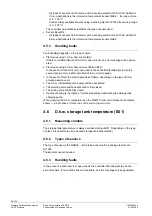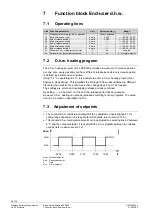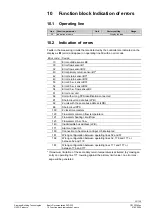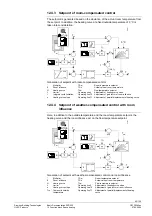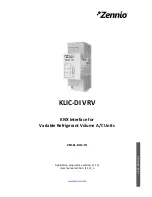
39/130
Siemens Building Technologies
Basic Documentation RVD230
CE1P2383en
HVAC Products
11 Function block Plant configuration
27.05.2004
•
With this kind of plant design, it can be assumed that the outside temperature hardly
ever drops below –5 °C. But the pump speed will also be increased above its minimum
in the case of heating up processes, when the outside temperature is above –5 °C
Lower pump speeds mean:
•
Energy savings due to reduced pumping power
•
Greater differential between heating flow and return temperature
•
Lower return temperatures
The heating circuit is controlled based on the signal received from the heating circuit
flow sensor.
Setting of the maximum flow temperature (operating line 95) defines the maximum flow
temperature setpoint on the one hand. On the other, the same setting defines the range
from which flow temperature the pump speed shall be increased.
The maximum flow temperature should always be selected as high as this is permitted
by the heating system. The higher the flow temperature setting, the longer the pump
runs at minimum speed. Also, the heating circuit’s maximum output will not be re-
stricted unnecessarily.
The illustration shows that at outside temperatures below operating point C, the pump
speed will be increased from minimum to maximum. To define the rate at which the pump
speed shall be increased, the radiators’ power factor is to be set. The power factor is the
ratio of radiator output at minimum pump speed and that at maximum pump speed:
radiator output at minimum speed
Power factor =
radiator output at maximum speed
The factory setting is 85 %. If the plant is correctly sized, this setting ensures a satisfac-
tory performance and, for this reason, necessitates readjustments only in exceptional
cases. Incorrect settings only have an impact at extremely low outside temperatures;
these are small however.
The power factor of the variable speed pump at minimum speed is to be set on operat-
ing line 60.
If, with plant types 2–x, 3–x and 4–x, the common flow temperature is not reached, the
speed of the heating circuit pump will not change because speed control only acts on
the heating circuit pump.
The intermediate circuit pump operates at maximum speed until the limit of maximum
return temperature limitation is exceeded. Then, the pump speed is continuously re-
duced, giving the heating water more time to transfer its heat to the storage tank.
The intermediate circuit pump is controlled according to the signal received from the
closest return sensor. The following setpoints and actual values are used:
Plant type
Actual value
(sensor)
Setpoint
2–1 B72
Other x–1
B71
2–2, 6–2
B72
3–2, 7–2
B71
[Maximum setpoint of the return temperature
during d.h.w. heating*]
minus
[differential to
the primary limit value with maximum limita-
tion of the secondary return temperature**]
1–3 B72
x–9 B72
Maximum setpoint of the return temperature
with d.h.w. heating
2–11, 2–12 only
during d.h.w. heating:
system pump Q1
B71
[Maximum setpoint of the return temperature
during d.h.w. heating]
minus
[differential to
the primary limit value with maximum limita-
tion of the secondary return temperature]
* Setting value operating line 176
** Setting value operating line 177
Maximum flow
temperature
Power factor
Control of the intermedi-
ate circuit pump


